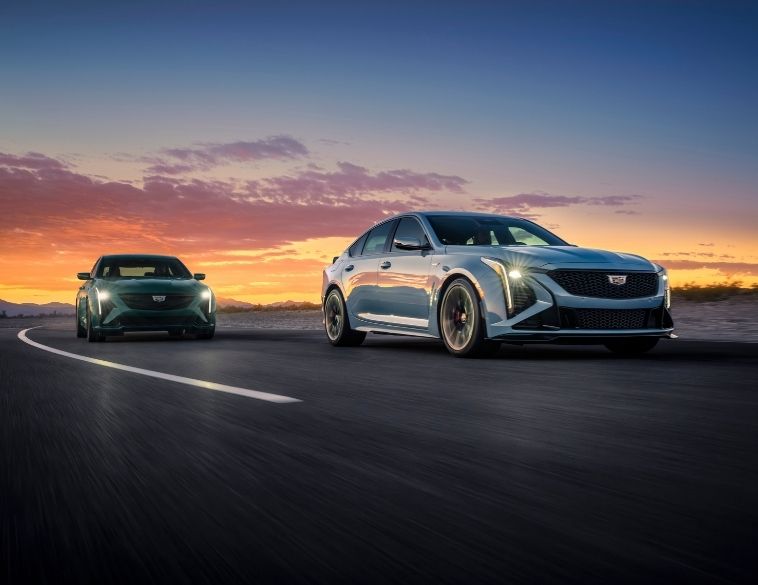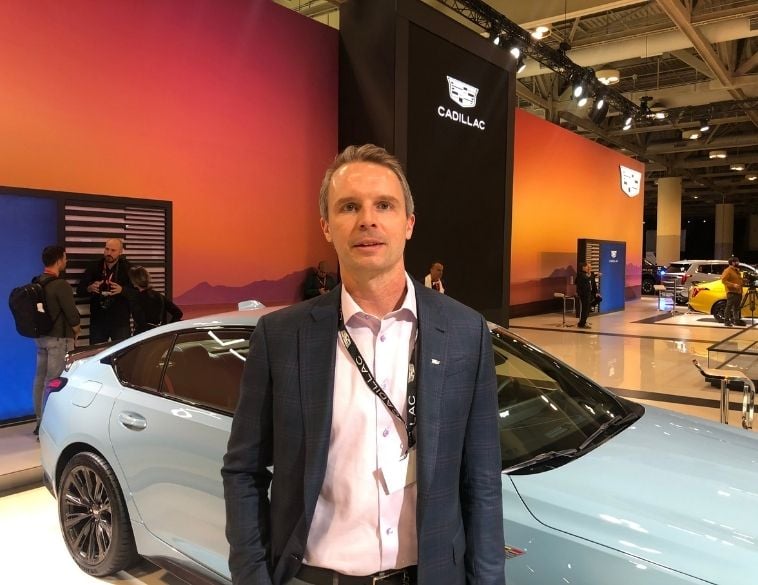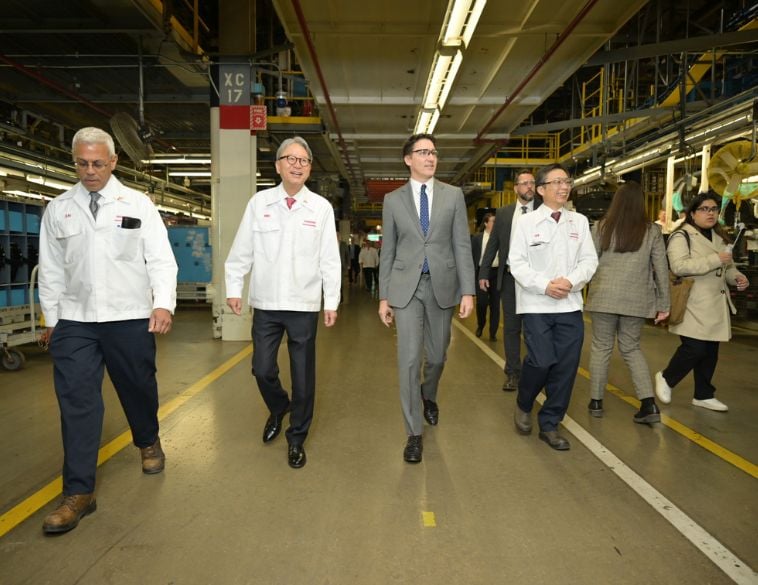Global Chief Engineer for the Cadillac CT5 explains how you can leverage technology to deliver ultra-high performance that feels decidedly human and very appealing.
Halo vehicles can be boon for both OEMs and franchised dealers. While they may not sell in significant numbers, they serve as a beacon for the brand and often result in customers purchasing other vehicles and perhaps, converting to that brand from another. Yet when we hear the term fun-to-drive (which is often used to describe the dynamics of a halo vehicle), the term can seem a bit misleading, especially in the current day and age. Increased computerization and electrification have in some respects, dumbed down drivers feel one reason why more people are gravitating to modern classic vehicles from the 1980s and 1990s. Yet it isn’t all doom and gloom.
There are some OEMs and engineers who are laser-focused on delivering an analogue driving experience in a digital age. Recently, Autosphere had a chance to sit down with Alex MacDonald, Global Chief Engineer for the Cadillac CT4 & CT5, asking him about what goes into making a truly fun-to-drive car like the hallowed CT5 V-Series Blackwing, which recently received a mid-life refresh. Here’s what he had to say:
Autosphere: Tell us a little about your role and some of your experiences in developing high-performance vehicles at General Motors.
Alex MacDonald: Currently, I’m the Global Chief Engineer for the CT4 & CT5. I’ve been in that role for about 20 months, which included working on the vehicle’s 2025 model year refresh. Before that, I was Vehicle Performance Manager for Corvette and Camaro.
In that role I was part of a team that did everything from snow and ice testing; to exhaust sound tuning, to Noise and Vibration tuning on regular roads, fuel economy testing and chassis and development testing in districts all around the U.S., as well as track testing at the famous Nürburgring Nordschleife in Germany. It was working with a really fun, dynamic group, focused on performance, and in the cubicle next to us were the team working on the Cadillac V Series, so we got to trade vehicles and gain experience from the work conducted by each team.
AS: In your view, what do you think is essential for creating a modern, truly fun, rear-wheel drive performance vehicle?
AM: I think there are a variety of things to consider. When we look at the CT5 V-Series Blackwing for example, we really focused on ‘isolated precision.’ What I mean by that is creating a vehicle that offers both touring comfort and sporty driving engagement, as well as true track capability. And that’s all done with technology. When we talk about rear-wheel drive vehicle dynamics today, a lot of that comes down to an electronic limited-slip rear differential (LSD) and how it operates. While some people will see the benefits of an LSD in providing extra traction when you scoot away from your mailbox in the morning or better grip off the line at the drag strip, this is only a small fraction of what an LSD is really designed to do.
It’s really about steering feel, vehicle handling and balance. We developed the software for our electronic LSD internally at GM and we’re quite proud of how integrated it is. You’ll see some manufacturers with a very binary control for the differential. In our case, it’s very analogue, making adjustments every 100 milliseconds with data input from sensors all around the vehicle. This translates into a very responsive driver input, so, let’s say for example, you’re driving on the track and forcing the differential open, with aggressive steering inputs, you will need to put steering corrections in very, very quickly to maintain your line because it’s a very neutral chassis.

AS: In today’s marketplace, why do you think we’ve often lost that sense of connection between the driver and the car and how can we reclaim it?
AM: It’s really about engineering the car to do what the driver wants it to. Often, we see engineers look at optimizing an electronic LSD in terms of track performance, the powertrain, and the chassis. Rarely do they think about the driver.
With this kind of approach, high-performance driving can seem more like a video game than a one-on-one, intimate experience between the vehicle and the driver. When you include the driver in that optimization approach, you start making different decisions about how you calibrate the e-LSD, the suspension, dampingall those thingsand that’s how you create a driver-focused vehicle that while embodying a lot of technology, feels analogue every time you get behind the wheel.
AS: When we hear OEMs and even dealers talk about enthusiast cars that are track-capable, what does it exactly mean?
AM: From our perspective, a performance vehicle that is deemed track capable, like the CT5 V-Series Blackwing is one that once the production hardware is available, is subject to a 24-hour durability test under track conditions. We build a car specifically to go for 24 hours but a key point to note is that it is not consecutive. When race teams run 24-hour events the cars have fast pit stops meaning they don’t have the opportunity to cool down, but when we conduct testing, there is a warmup and a cool-down lap, though that 24-hour clock doesn’t include those and begins when we start the first hot lap on the track. When doing these tests, only the consumables can be replaced, such as tires and sometimes brakes [there is a specification for how long they need to last].
The rest of the vehicle, such as the engine, transmission and suspension need to make it through this 24-hour durability test before we can say the car is track capable. And for us, that’s what’s so magical about a car like the CT5 V-Series Blackwing. It seats four people comfortably and you can drive it around town all day, but you can take it to the track and thrash it in a way that’s normal for a track driver without expecting any issues. An owner can take the vehicle to your typical track day, which often includes five sessions, and do that multiple times a year and have a great experience each time.
AS: Can you tell us a little about some of the new features on the CT5 V-Series Blackwing for 2025?
AM: Besides an exterior facelift, a big announcement for the 2025 model year is a new, curved 33-inch interior display that combines the instrument panel and infotainment features in a single display. This brings with it some software capability that’s expanded for a V-Series Blackwing customer, including a Performance Data Recorder. It’s a huge suite of data analysis software that’s available on GM vehicles that lets you integrate video with your lap times.
Plus, with detailed CAN BUS data such as information from the engine, you can feed that information directly into the PDR. Plus, it’s the same software that Cosworth uses on their race cars and that functionality is available in this new 33-inch display instead of having to access it via your own computer. It’s a feature that has been around for some time but has now been enhanced to deliver a better and improved experience. And, to give you an idea of how focused we are on this, we have passionate race engineers working on this thing all the time. And they came up with the idea that really, most of the time with the car like the CT5 V-Series Blackwing, you’re at a track day but not racing wheel-to-wheel and often, there is a right seat instructor with you when you go out on the track.
With the new interior display, there are features on the screen specifically for a right seat instructor, so they know when you’re braking and when you’re on the throttle. Having access to this data helps them give you better advice, whether you’re new to track driving or are experiencing a different track for the first time. Ultimately, it’s about helping the instructor help you have a better experience behind the wheel.



